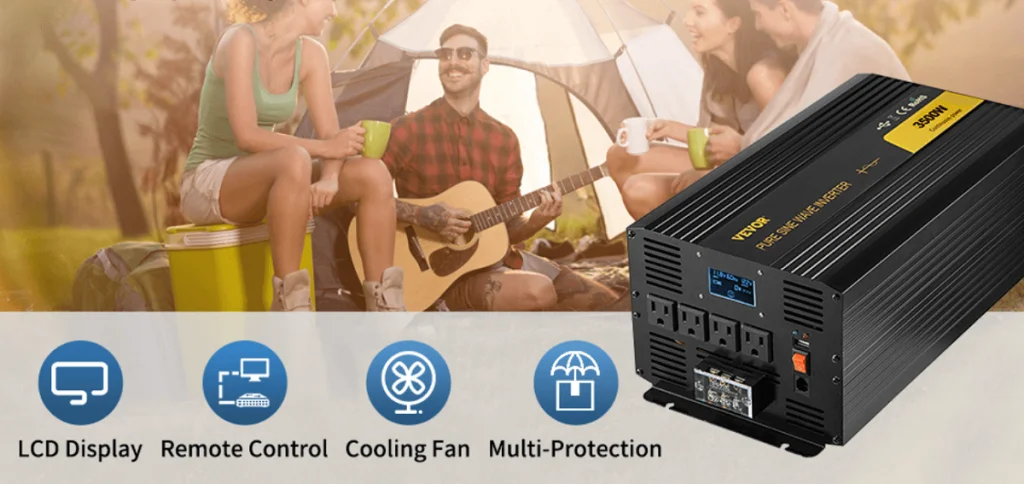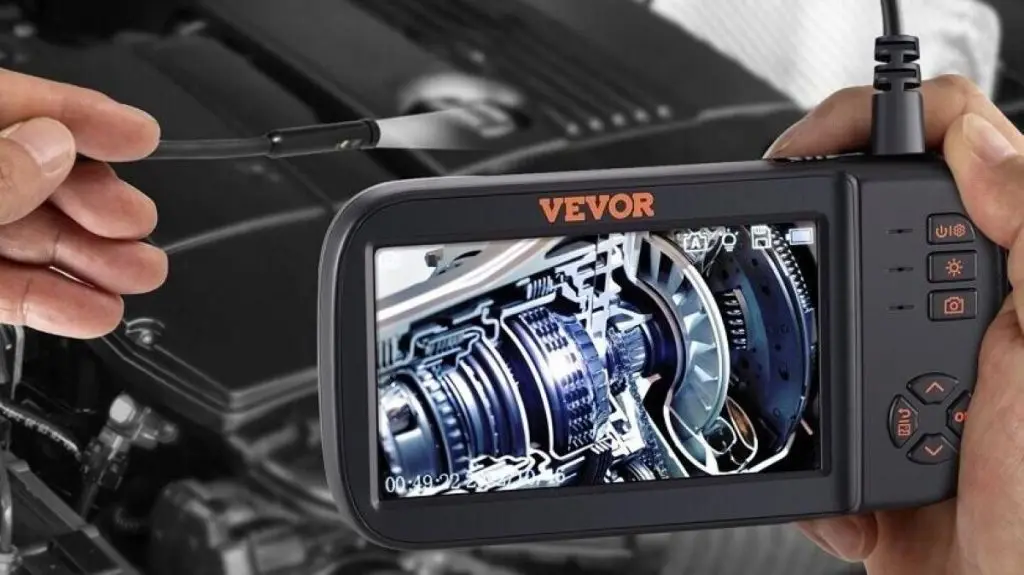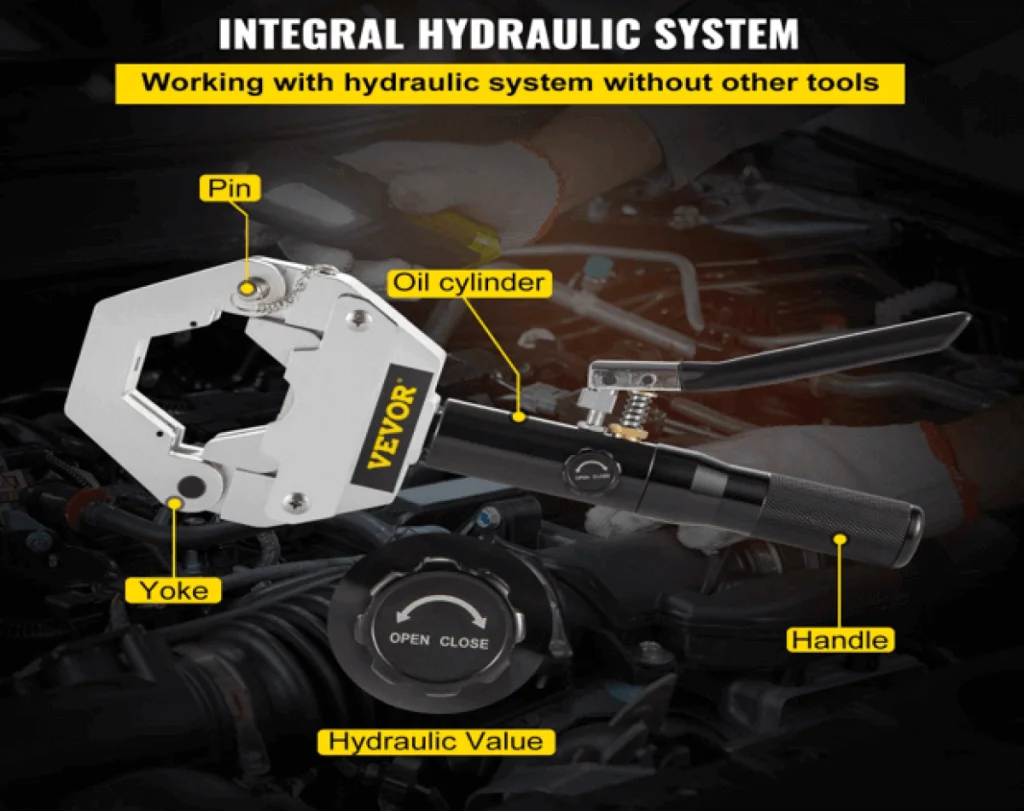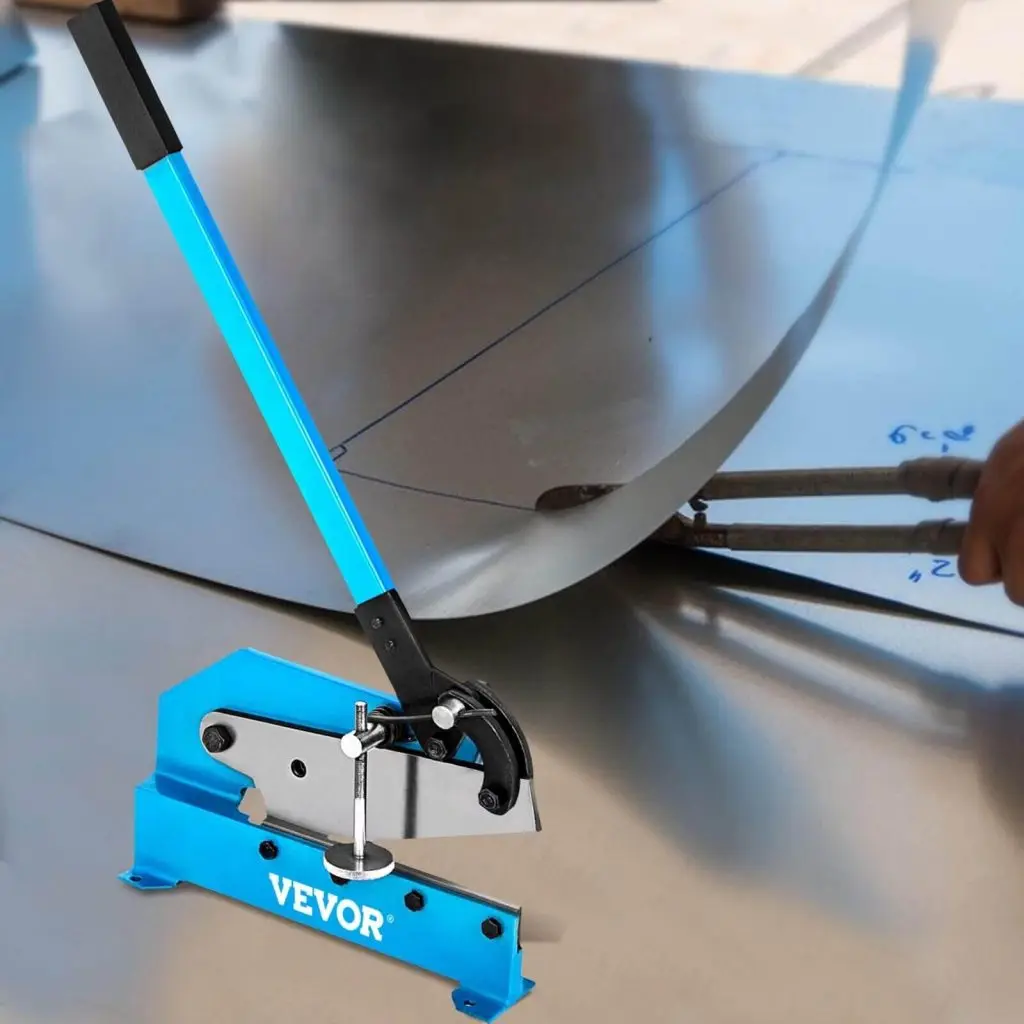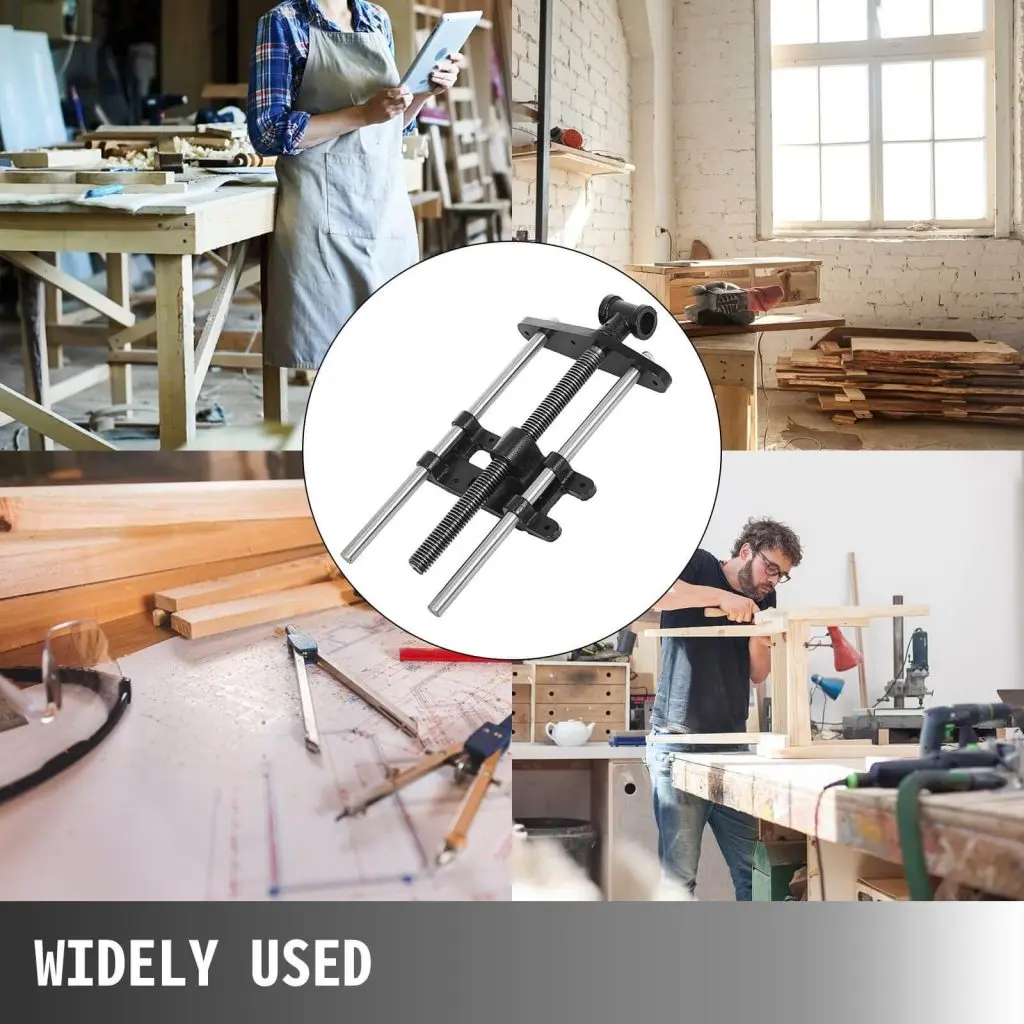Are you ready to harness the full potential of your VEVOR 3500 watt inverter? Whether you’re a seasoned DIY enthusiast or just looking to ensure your home backup system is top-notch, understanding the intricacies of your inverter is crucial. Our comprehensive guide to the VEVOR 3500 watt inverter manual will walk you through everything you need to know to operate, troubleshoot, and maintain your device efficiently.
Table of contents
Models and Denotations

Safety First
WARNING! Shock hazard. Keep away from children.
1-1. The inverter generates the same potentially lethal AC power as a normal household wall outlet. Treat it as if you are using any other AC outlet.
1-2. Do not insert foreign objects into the inverter’s AC outlet, fan or vent openings.
1-3. Do not expose the inverter to water, rain, snow or spray.
1-4. Do not under any circumstance, connect the inverter to AC power.
WARNING! Heated surface.
1-5. The inverter housing may become uncomfortably warm, reaching 140F (60℃) under extended high power operation. Ensure at least 2 inches (5 cm)of airspace is maintained on all sides of the inverter. During operation, keep away from materials that may be affected by high temperature.
WARNING! Explosion hazard.
1-6. Do not use the inverter in the presence of flammable fumes or gases, such as in the bilge of a gasoline powered boat, or near a propane tanks. Do not use the inverter in an enclosure containing automotive-type, lead-acid batteries. These batteries, unlike sealed batteries, emit explosive hydrogen gas which can be ignited by sparks from electrical connection。
CAUTION!
1-7. Do not connect live AC power to the inverter’s AC outlets. The inverter will be damaged even if it is switched OFF.
1-8. Do not expose the inverter to temperatures exceeding 104F (40℃). CAUTION! Do not use the inverter with the following equipment:
1-9. Small battery operated products such as rechargeable flashlights, some rechargeable shavers, and nightlights that are plugged directly into an AC receptacle to recharge.
1-10. Certain battery chargers for battery packs used in hand powered tools. These chargers will have warning labels stating that dangerous voltages are present at the charger’s battery terminals.
1-11. Note, DC voltage of battery should be similar to input DC voltage of power inverter (for example DC12V of battery should be connected with input voltage 12V of the inverter).
Product Features and Applications
Product Features
- Pure sine wave or modified sine wave
- Soft start
- PWM (Pulse Width Modulation)
- Microprocessor based design
- With power ON/OFF switch and LED indicator
- Overload protection / Overvoltage protection / Short Circuit protection/Over temperature protection/Reverse polarity protection (by fuses)
Product Applications
Power tools series: Electric Saw, Drilling Machine, Grinder, Sandblast Machine, Punching Machine, Weeding Machine, Air Compressor etc.
Office series:Computer, Printer, LCD Monitor, Scanning Machine, etc.
Household Appliance series: Dust Collector, Fan, Lamp or LED, Sewing Machine etc
Kitchen Appliance series: Microwave Oven, Fridge, Freezer, Coffee maker.
Pure sine wave and modified sine wave inverters
The inverter come in two types; pure sine wave power type and modified sine wave type. In the pure sine wave power inverter, the 240V AC output harmonically follows a smooth sine wave and is almost identical to normal mains electricity. As a result, the pure sine wave output would be better for most appliances than the modified sine wave output.
A Graphic Comparison of Modified Sine Wave and Pure Sine Wave is shown below:

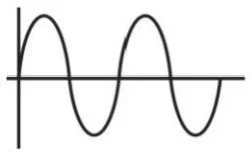
Modified Sine Wave and Pure Sine Wave, respectively
Guidelines
Installation Conditions
For safe and optimum performance, install the inverter in a location that is:
- Dry-Do not expose to water drips or spray. Dry-Do not expose to water drips or spray.
- Cool-Operate only in ambient temperatures between 32 °F (0 °C)and 104 °F (40 °C). Keep away from heating vents or other heat producing equipment.
- Safe -Do not install inverter in a compartment with batteries or flammable liquids, such as gasoline or explosive vapors.
- Well ventilated -Allow at least 2 inches (5 cm)clearance above and on all sides of the unit for proper cooling.
- Clean and free of dust and dirt-This is especially important if the inverter is used in a dusty working environment. Select a Suitable Location.
Working Principle
The inverter works in two stages. During the first stage, the DC to DC converter increases the DC input voltage from the power source(e.g., A 12V battery)to 300V DC. In the second stage, the high voltage DC is converted to the watts you need (AC) using advanced power MOSFET transistors or IGBT technology in a full bridge configuration. The result is excellent overload capability and the capacity to operate difficult reactive loads.
Connection Method
- Attach the ring type connector marked with red to the positive (+) DC terminal on the inverter, and attach the ring connector marked with black to the negative (-) DC terminal.
CAUTION!
A reverse polarity connection (positive to negative)may damage the inverter (Fuse). Damage caused by a reverse polarity connection would probably invalidate your warranty.
WARNING:Sparking may occur when connecting the unit to the battery, make sure no flammable fumes are present before making any connections.
- Tighten the nut on each DC terminal by hand until it is snug. If the power more than 1800W, please use tools to tight up the screw.
- When the inverter is not in use, unplug it from the 12V/24V/48V DC outlet to avoid the battery’s discharge.
CAUTION: Before using the inverter, please provide a ground connection wire. On the rear panel of the inverter is a terminal fitted with a nut for connecting to the inverter and to the earth terminal of the AC output socket. Please choose heavy duty, insulated green/yellow wire. Drive into the ground to a depth of 1-2m or more. In a vehicle, connect the inverter to the chassis of the vehicle. In a boat, connect to the boat’s grounding system.
Battery’s Charge
We advise that please use deep cycle battery. If you hear the low voltage alarm, please stop the inverter immediately. When the battery is fully charged, the inverter can be used again. If you use the inverter in a car, then it would be necessary to run the engine of your car after each time you use the inverter. You can run the engine for 10 minutes or so to recharge the battery.
Inverter’s Working Status
- When a 12V/24V/48V DC outlet or battery properly connected to the inverter, turn on the ON/OFF, the green Power indicator will light, and it delivers AC power to the outlets.
- Plug the AC appliances you wish to operated into the AC outlet(s)and switch your appliances on, switch one at a time.
NOTICE:When connect to the appliances, remember to turn on the inverter before turn on the appliance.
- If the audible alarm be ignored, the inverter may be automatically shut down when the battery voltage drops to 9.8-10.2V/19.6-20.4V/39.2-40.8V. In order to prevent damage to the battery from excessive discharge.
- If the AC appliance’s rated power is higher than the inverters rating (or the appliance draws excessive surge power), the inverter will shut down. The red FAULT indicator will light.
- If the inverter exceeds a safe operating temperature, due to insufficient ventilation or a high surrounding temperature, it will automatically shut down. The red FAULT indicator will light and the audio warning alarm will sound.
- If a defective battery charge system has caused the battery voltage to rise to a dangerously high level, the inverter will automatically shut down.
- The cooling fan is designed to operate only when the temperature goes up or when the loads are applied.
CAUTION: Although the inverter incorporates the protection function against over-voltage, there would be still the possibility of getting the unit damaged if the input voltage exceeds 16V/32V/64V.
The Sketch of Inverter
Modified sine wave150W-600W, Pure sine wave150W-600W

Modified sine wave150W-600W, Pure sine wave150W-600W
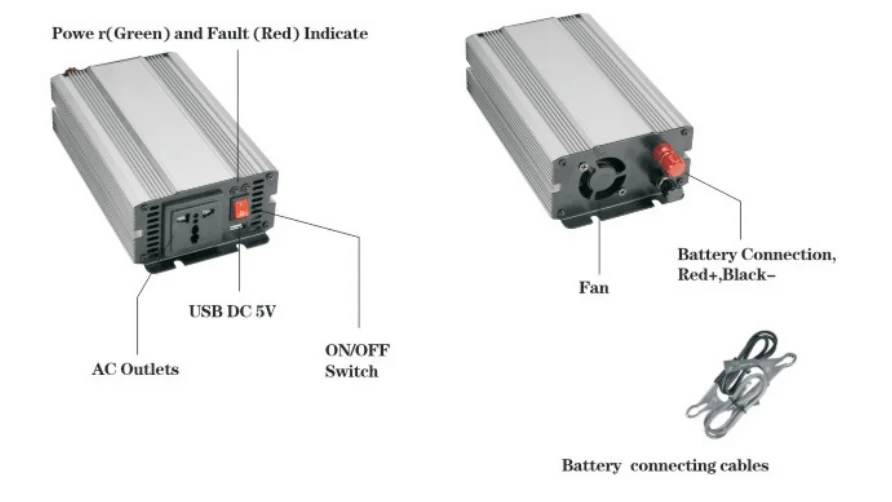
Modified sine wave 800W-2000W, Pure sine wave 800W-2000W

Modified sine wave 3000W-6000W, Pure sine wave 3000W-4000W
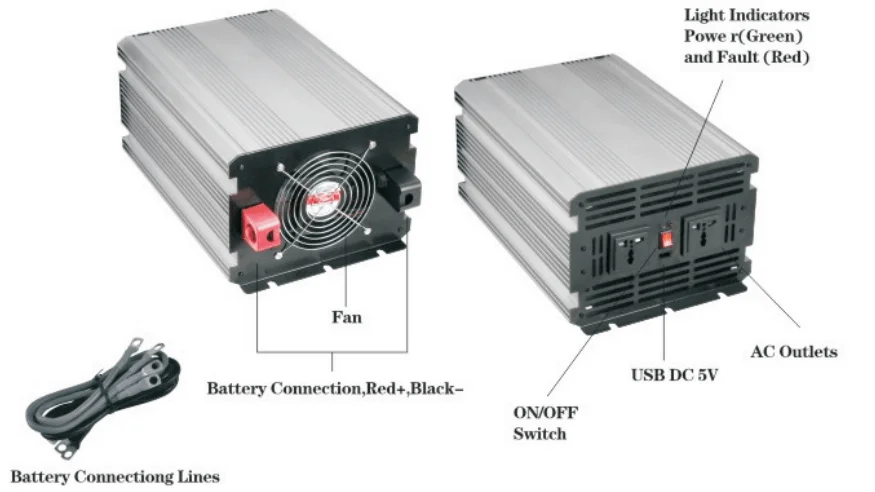
Pure sine wave 5000W-6000W

Inverter to Battery Connections Details、

Tips: 48V and 24V inverters are connected in similar ways, but the batteries in series.
Trouble Shooting
AC appliances do not work, and the green power indicator does not light.
| CAUSES | SOLUTION |
| Bad battery | Check the battery, replace it if necessary |
| Revers connection ofnegative and positivepoles | To correct the connection to battery, the inverter may be damaged.Replace the fuse inside inverter (outside warranty cover) |
| Untight connection of cables | Check the cables and theconnection, screw tight thewiring terminal |
The electric appliances do not work, and the red FAULT indicator of the inverter lights
| CAUSES | SOLUTION |
| Overload shut off due to rated power of appliances exceeding the inverter’s rated power | Use appliances having power below the inverter’s rated power |
| Overload shut off due to overhigh peak power despite power of electric appliances lower than the inverter’s rated power | Since the peak power of the electric appliances exceeds the peak power of the inverter, use an appliance with a peak power consistent with the inverter |
| The battery is over discharged (inverter gives an alarm) | Replace the battery or use a battery charger to charge your battery |
| Over temperature shut off due to bad ventilation | Switch off the inverter and let it get cooled for 15 minutes. Clear objects around the fan and the inverter. Place the inverter at a cool place. Reduce load according to requirements. Restart |
| Too large input current | Check the working state of the charging system. Make sure the output voltage of the battery is within the proper voltage |
The measured output current of the inverter is too low
| CAUSES | SOLUTION |
| The range of reading of common ammeter is too small | Measure“modified sine wave” with a “real effective value multimeter” to get the accurate data |
| Too low current of the inverter | Charge the battery or change battery |
The inverter gives out an alarm sound
| CAUSES | SOLUTION |
| Low voltage alarm | Shorten the wire or use wider cable. Charge the battery |
| Over temperature protection | Make the inverter get cooler, improve ventilation around the inverter. Place the inverter at a cool place. Feed the load according to requirements |
| AC appliances draw too much power | Use bigger power inverter |
| Poor connection | Check the connection and tighten it. |
Specifications
| ITEMS | 150 | 300 | 500 | 600 | 800 |
| RatedPower | 150W | 300W | 500W | 600W | 800W |
| SurgePower | 300W | 600W | 1000W | 1200W | 1600W |
| Output Voltage | AC110V±10% | ||||
| AC220V/230V±10% | |||||
| Input Voltage | 12/24/48V | 12/24/48V | 12/24/48V | 12/24/48V | 12/24/48V |
| Output Waveform | Pure sine wave or Modified sine wave | ||||
| ITEMS | 1000 | 1500 | 2000 | 2500 | 3000 |
| Rated Power | 1000W | 1500W | 2000W | 2500W | 3000W |
| Surge Power | 2000W | 3000W | 4000W | 5000W | 6000W |
| Output Voltage | AC110V±10% | ||||
| AC220V/230V±10% | |||||
| Input Voltage | 12/24/48V | 12/24/48V | 12/24/48V | 12/24/48V | 12/24/48V |
| Output Waveform | Pure sine wave or Modified sine wave | ||||
| ITEMS | 4000 | 5000 | 6000 |
| Rated Power | 4000W | 5000W | 6000W |
| Surge Power | 8000W | 10000W | 12000W |
| Output Voltage | AC110V±10% | ||
| AC220V/230V±10% | |||
| Input Voltage | 12/24/48V | 12/24/48V | 12/24/48V |
| Output Waveform | Pure sine wave or Modified sine wave | ||
Statement:there are some differences between the image and the real object, please subject to real objects;Products are being updated constantly,if you need to learn more, please contact us.
Do not open the inverter without permission!
FAQs about VEVOR 3500 Watt Inverter
Q: What safety precautions should I follow when using the VEVOR 3500 watt inverter?
A: Always ensure the inverter is installed in a cool, dry, and well-ventilated area. Keep it away from children, water, and flammable materials. Refer to the safety instructions section of the manual for detailed guidance.
Q: Can the VEVOR 3500 watt inverter power household appliances?
A: Yes, it can power a wide range of household AC products such as TVs, computers, and air conditioners, as long as the total wattage does not exceed 3500 watts.
Q: What should I do if the inverter is not working?
A: Check the troubleshooting section of the VEVOR 3500 watt inverter manual. Common solutions include checking battery connections, ensuring the inverter is not overloaded, and verifying that the battery voltage levels are adequate.
Final Words
For optimal performance and longevity of your VEVOR 3500 watt inverter, familiarizing yourself with the detailed instructions and guidelines provided in the manual is essential. Ready to maximize the efficiency of your power setup? Download the full VEVOR 3500 watt inverter manual today and take the first step towards expert handling of your device. Click here to access the manual and ensure your equipment runs flawlessly!

